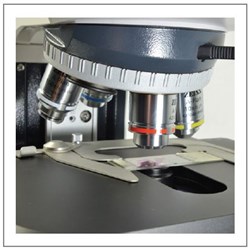Embeddable "Laser Particles" Key To MIT, Harvard Scientists' Nano-Imaging
By Jof Enriquez,
Follow me on Twitter @jofenriq

Scientists at the Massachusetts Institute of Technology (MIT), Massachusetts General Hospital (MGH), and Harvard Medical School have developed a new imaging technique using tiny embedded "laser particles," which emit laser light to illuminate dense tissue. The resulting images are six times higher than what current fluorescence-based microscopes are capable of producing.
Optical resolution by standard microscopes is limited to about a wavelength of light because of the diffraction limit — roughly a few hundred nanometers. Some imaging techniques — in particular, laser confocal microscopy — can beat the diffraction limit, as they can illuminate sample tissue one subwavelength spot at a time by inducing fluorescence from injected dyes. However, emission from other cell components reduces the sensitivity of such methods when scanning thick tissues.
The imaging technique developed by MIT and Harvard researchers overcomes this limitation using nanowires of lead iodide perovskite measuring just 3–7 micrometers long and 300–500 nanometers (nm) across. This material acts as a semiconductor laser and can be “pumped” with green light to stimulate laser emission at a wavelength of 775 nanometers, according to an article in APS Physics.
When hit by a probe beam 2.5 μm wide, these nano-sized rods emitted diffuse fluorescent light. But, when tuned to a certain “lasing threshold," the particles emitted light even more intensely, further distinguishing them from the lit background. The sharper images using this technique can have six times more resolution than images produced by current fluorescence-based microscopes, according to the research team.
“That means that if a fluorescence microscope’s resolution is set at 2 micrometers, our technique can have 300-nanometer resolution — about a sixfold improvement over regular microscopes,” MIT graduate student and research team leader Sangyeon Cho said in an MIT News article. “The idea is very simple but very powerful and can be useful in many different imaging applications.”
In biological tissues, scientists using the LAser particle Stimulated Emission (LASE) microscopy technique can, theoretically, image certain target layers or specific spots embedded with the laser particles.
"Only those particles in the beam’s focus will absorb enough light or energy to turn on as lasers themselves. All other particles upstream of the path’s beam should absorb less energy and only emit fluorescent light," explained the researchers. "We expect this will be very powerful when applied to biological tissue, where light normally scatters all around, and resolution is devastated. But if we use laser particles, they will be the narrow points that will emit laser light. So we can distinguish from the background and can achieve good resolution."
In the future, laser particles can be made tiny enough to be injectable, implantable, or swallowable in biomedical experiments. Inside the body, they can attach to organelles or protein assemblies inside cells, where such particles should allow these structures to be imaged with 10-nanometer resolution. At that point, the cells themselves would glow like lasers and serve as internal light sources, something the researchers are working on next.
